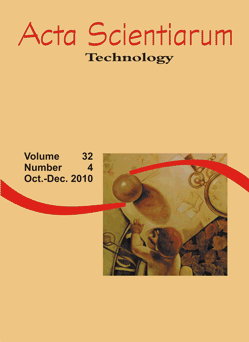<b>Improvement of the electrochemical determination of antioxidant using cationic micellar environment</b> - 10.4025/actascitechnol.v32i4.6945
DOI:
https://doi.org/10.4025/actascitechnol.v32i4.6945Keywords:
ascorbic acid, micellar system, cationic surfactantAbstract
Ascorbic acid (AA) is an important compound of the human diet, in the metabolism acting mainly as exogenous antioxidant. A method for electrochemical detection of Ascorbic acid (AA) with a GCE was developed using a cationic surfactant cetylpyridinium chloride (CPC). The presence of CPC influences the electrochemical behaviour of AA, reduces the applied potential to measure AA oxidation followed by an increase in the peak current. In the optimized conditions the AA determination was possible in the linear range of 5.0 x 10-7 mol L-1 - 4.3 x 10-4 mol L-1 with a detection limit (S/N = 3) of 2.0 x 10-7 mol L-1. The applicability of the method is in the sensitivity and selectivity of the GCE for the AA detection as well as the simplicity of the demonstrated method using an electrode without modifying and without pre-treatment of samples. Recovery tests presented values of 98 - 103% suggesting the method has no significant interference and making possible to be successfully used for AA determination in complex samples.Downloads
Download data is not yet available.
Downloads
Published
2010-12-02
How to Cite
Mello, L. D., Reis, A. P. dos, & Kubota, L. T. (2010). <b>Improvement of the electrochemical determination of antioxidant using cationic micellar environment</b> - 10.4025/actascitechnol.v32i4.6945. Acta Scientiarum. Technology, 32(4), 421–425. https://doi.org/10.4025/actascitechnol.v32i4.6945
Issue
Section
Chemistry
License
DECLARATION OF ORIGINALITY AND COPYRIGHTS
I Declare that current article is original and has not been submitted for publication, in part or in whole, to any other national or international journal.
The copyrights belong exclusively to the authors. Published content is licensed under Creative Commons Attribution 4.0 (CC BY 4.0) guidelines, which allows sharing (copy and distribution of the material in any medium or format) and adaptation (remix, transform, and build upon the material) for any purpose, even commercially, under the terms of attribution.
Read this link for further information on how to use CC BY 4.0 properly.















8.png)




